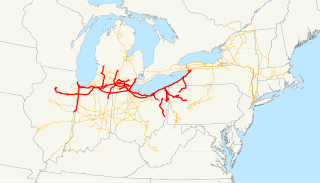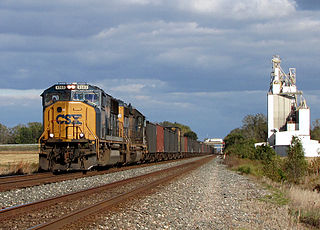Related Research Articles

The Baltimore and Ohio Railroad was the first common carrier railroad and the oldest railroad in the United States, with its first section opening in 1830. Merchants from the city of Baltimore, which had benefited to some extent from the construction of the National Road early in the century, wanted to continue to compete for trade with trans-Appalachian settlers with the Albany-Schenectady Turnpike built in 1797, and the newly constructed Erie Canal, opened in 1825,, another canal being proposed by Pennsylvania, the Chesapeake and Ohio Canal, and the James River Canal, which directed traffic toward Richmond and Norfolk, Virginia. At first, the B&O was located entirely in the state of Maryland, its original line extending from the port of Baltimore west to Sandy Hook. There it connected with Harper's Ferry across the Potomac into Virginia, and also with the navigable Shenandoah River.

The Lake Shore and Michigan Southern Railway, established in 1833 and sometimes referred to as the Lake Shore, was a major part of the New York Central Railroad's Water Level Route from Buffalo, New York, to Chicago, Illinois, primarily along the south shore of Lake Erie and across northern Indiana. The line's trackage remains a major rail transportation corridor used by Amtrak passenger trains and several freight lines; in 1998, its ownership was split at Cleveland between CSX to the east and Norfolk Southern in the west.

The Western Maryland Railway was an American Class I railroad (1852–1983) which operated in Maryland, West Virginia, and Pennsylvania. It was primarily a coal hauling and freight railroad, with a small passenger train operation.

The Capital Subdivision is a railroad line owned and operated by CSX Transportation in the U.S. state of Maryland and the District of Columbia. The line runs from near Baltimore, Maryland, southwest to Washington, D.C., along the former Baltimore and Ohio Rail Road (B&O) Washington Branch. The subdivision's Alexandria Extension provides a connection to Virginia and points south.
The Lake Shore Subdivision is a railroad line owned by CSX Transportation in the U.S. states of New York and Pennsylvania. The line runs from Buffalo, New York, southwest along the shore of Lake Erie to Erie, Pennsylvania, along the former New York Central Railroad main line.
The Erie West Subdivision is a railroad line owned by CSX Transportation in the U.S. states of Pennsylvania and Ohio. The line runs from Erie, Pennsylvania, southwest along the shore of Lake Erie to Cleveland, Ohio, along the former New York Central Railroad main line.

The Mountain Subdivision is a railroad line owned and operated by CSX Transportation in the U.S. states of Maryland and West Virginia. The line runs from Cumberland, Maryland, west to Grafton, West Virginia, along the original Baltimore and Ohio Railroad (B&O) main line. It was known as the West End Subdivision until the B&O's absorption into the Chessie System, and included the B&O's original crossing of the Allegheny Mountains. Through CSX traffic to the west from Cumberland now uses the Keystone Subdivision over Sand Patch Grade.

The Hanover Subdivision is a railroad line owned and operated by CSX Transportation in the U.S. states of Maryland and Pennsylvania. The line runs from Baltimore, Maryland, west to Hagerstown, Maryland, along several former Western Maryland Railway (WM) lines. It meets the Baltimore Terminal Subdivision at its east end, and the Lurgan Subdivision heads both north and west from its west end.
The Keystone Subdivision is a railroad line owned and operated by CSX Transportation in the U.S. states of Maryland and Pennsylvania. The line runs from Cumberland, Maryland, west to McKeesport, Pennsylvania, along a former Baltimore and Ohio Railroad (B&O) line. The line includes the well-known Sand Patch Grade over the Allegheny Mountains.
The Ohio River Subdivision is a railroad line owned and operated by CSX Transportation in the U.S. state of West Virginia. The line runs from Wheeling southwesterly along the east (left) shore of the Ohio River to Huntington along a former Baltimore and Ohio Railroad line.

The Harrisburg Subdivision is a railroad line owned by CSX Transportation in the U.S. state of Pennsylvania. The line is located in the city of Philadelphia, connecting Greenwich Yard and the Philadelphia Subdivision with the Trenton Subdivision along a former Pennsylvania Railroad line. Much of the Harrisburg Subdivision is the High Line or West Philadelphia Elevated along 31st Street over the 30th Street Station area.
The Bridgeport Subdivision is a railroad line owned and operated by CSX Transportation in the U.S. state of West Virginia. The line runs from Grafton west to Clarksburg along a former Baltimore and Ohio Rail Road line. At its east end, the Bridgeport Subdivision becomes the Mountain Subdivision; its west end is at the Short Line Subdivision.

The Metropolitan Subdivision is a railroad line owned and operated by CSX Transportation in the District of Columbia and the U.S. state of Maryland. The line runs from Washington, D.C., northwest to Weverton, Maryland, along the former Metropolitan Branch of the Baltimore and Ohio Railroad.

The Garrett Subdivision is a railroad line owned and operated by CSX Transportation in the U.S. states of Ohio and Indiana. The line runs from Deshler, Ohio, west to Willow Creek, Indiana, along a former Baltimore and Ohio Railroad (B&O) line. At its east end, just east of Deshler, the Garrett Subdivision becomes the Willard Subdivision. The line crosses the Toledo Subdivision at Deshler and ends at the junction with the Porter Subdivision and Barr Subdivision at Willow Creek.
The Marietta Subdivision is a railroad line owned by CSX Transportation and operated by Belpre Industrial Parkersburg Railroad in the U.S. states of West Virginia and Ohio. The line runs from Parkersburg, West Virginia, west to Belpre, Ohio, and north via Marietta to Relief along a former Baltimore and Ohio Rail Road line. Its south end is at a connection to the Ohio River Subdivision; the line crosses the Ohio River on the Parkersburg Bridge between Parkersburg and Belpre.
The CL&W Subdivision is a railroad line owned and operated by CSX Transportation in the U.S. state of Ohio. The line runs from a junction with the New Castle Subdivision at Sterling northwest to Lorain along a former Baltimore and Ohio Rail Road line. It junctions with the Cleveland Subdivision at Lester and the Greenwich Subdivision at Grafton.

The P&W Subdivision is a railroad line owned and operated by CSX Transportation, the Allegheny Valley Railroad (AVR), and the Buffalo and Pittsburgh Railroad (BPRR) in the U.S. state of Pennsylvania. The line runs from Rankin north through Pittsburgh to West Pittsburg along a former Baltimore and Ohio Railroad line, once the Pittsburgh and Western Railroad.

The Pittsburgh Subdivision is a railroad line owned and operated by CSX Transportation in the U.S. state of Pennsylvania. The line runs from McKeesport northwest through Pittsburgh to West Pittsburg along a former Pittsburgh and Lake Erie Railroad line. Its east end is at Sinns, across the Youghiogheny River from McKeesport at Liberty, at the west end of the Keystone Subdivision. It junctions with the Mon Subdivision at McKeesport and the P&W Subdivision in Rankin; at its west end it becomes the New Castle Terminal Subdivision.

The Baltimore Terminal Subdivision is a railroad line owned and operated by CSX Transportation in the U.S. state of Maryland. The line runs from Baltimore to Halethorpe along the original Baltimore and Ohio Railroad (B&O) line, one of the oldest rail lines in the United States and the first passenger railroad line. At its east (north) end, it connects with the Philadelphia Subdivision; its west (south) end has a junction with the Capital Subdivision and the Old Main Line Subdivision.

The Cumberland Terminal Subdivision is a railroad line owned and operated by CSX Transportation in the Cumberland, Maryland area. The line centers on the Cumberland rail yard and is a junction with three other subdivisions.
References
- ↑ "CSX Timetables: Fairmont Subdivision". Archived from the original on November 26, 2002.
- ↑ "FT-Fairmont Sub". RadioReference.com.
- ↑ "CSX Huntington East Timetable" (PDF). MultimodalWays.
- ↑ "PRR Chronology, 1852" (PDF). Pennsylvania Railroad Technical & Historical Society. March 2005. Archived from the original (PDF) on 2006-03-16.
- ↑ Ross, Phil (1994). "The Scotts Run Coalfield from the Great War to the Great Depression: A Study in Overdevelopment". West Virginia History. Vol. 53. West Virginia Department of Arts, Culture and History. pp. 21–42.